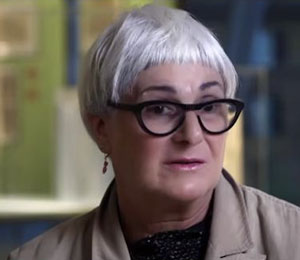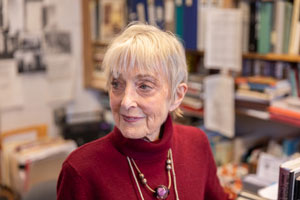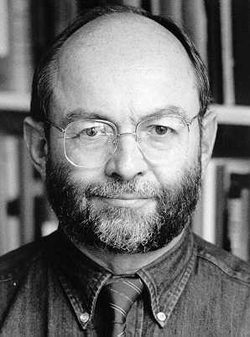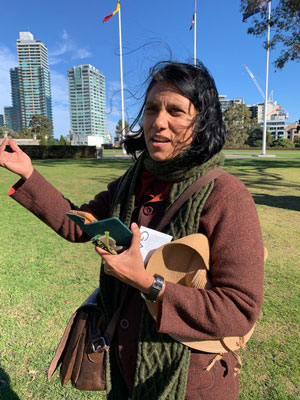-
Membership
Membership
Anyone with an interest in the history of the built environment is welcome to join the Society of Architectural Historians -
Conferences
Conferences
SAH Annual International Conferences bring members together for scholarly exchange and networking -
Publications
Publications
Through print and digital publications, SAH documents the history of the built environment and disseminates scholarship -
Programs
Programs
SAH promotes meaningful engagement with the history of the built environment through its programsMember Programs
-
Jobs & Opportunities
Jobs & Opportunities
SAH provides resources, fellowships, and grants to help further your career and professional life -
Support
Support
We invite you to support the educational mission of SAH by making a gift, becoming a member, or volunteering -
About
About
SAH promotes the study, interpretation, and conservation of the built environment worldwide for the benefit of all
2023 SAH Fellows

Architectural historian Annmarie Adams holds the Stevenson Chair at McGill University, Montréal. Jointly appointed in the Peter Guo-hua Fu School of Architecture and the Department of Social Studies of Medicine (SSoM), Adams was educated at the University of California, Berkeley. Her research focuses on the cultural landscapes of homes and hospitals, with emphasis on how to read the medical beliefs and gender expectations that are inscribed in the built environment. Her 1996 book, Architecture in the Family Way: Women, Houses, and Doctors, 1870–1900, won the Jason A. Hannah Medal from the Royal Society of Canada as an outstanding contribution to the history of medicine. Designing Women: Gender and the Architectural Profession, co-authored with sociologist Peta Tancred in 2000, provides an interdisciplinary study of Canada’s women architects. In 2008, Adams published Medicine by Design: The Architect and the Modern Hospital, 1893–1943, which looks inside healthcare planning. With funding from the Social Science and Humanities Research Council of Canada, she is currently writing a book on the life of Maude Abbott as seen through 10 spaces occupied by the pioneering physician.
Adams’ expertise on health and design is much cited by the media, including The Atlantic, Elle Décor, Financial Times Magazine, The Guardian, Nature, The New York Times, and WIRED. She is a leader in architectural and medical education, having served as chair of the Canadian Council of University Schools of Architecture and, currently, as vice president of the Canadian Society for the History of Medicine. At McGill, she has served as director of the School of Architecture and chair of SSoM. She is a Fellow of the Royal Architectural Institute of Canada and the Canadian Academy of Health Sciences. Adams has been a member of the Society of Architectural Historians since 1988. She has served on the SAH Board (2019–2022), was local co-chair of the SAH 2021 annual meeting, and is this year’s Eduard F. Sekler Talk speaker.

Maristella Casciato—architect, architectural historian and educator—is senior curator and head of architectural collections at the Getty Research Institute in Los Angeles (2016–present). During her tenure she has been responsible for major acquisitions such as Frank Gehry Papers, 1954–1988; Paul Revere Williams, the complete archives; Brenda Levin, the complete archives; Lebbeus Woods, drawings for “A-City”; and Erich Mendelsohn, projects developed in his American years. She has co-curated several exhibitions at the Getty, including Berlin-Los Angeles: Space for Music (2017), The Metropolis in Latin America, 1830–1930 (2017), MONUMENTality (2018) and Bauhaus Beginnings (2019). Casciato was awarded a Fulbright grant in 1992 and a Graham Foundation Publication grant in 2016. At the Canadian Centre for Architecture in Montréal she was Mellon Senior Fellow (2010) prior to being appointed associate director of research (2012–2015). She has been an associate professor and taught at Roma Tor Vergata, at the University of Bologna, and in several schools in the USA. Her interest in the planning of Chandigarh started in the late 1990s. On this topic she co-curated with Stanislaus Von Moos the exhibition, Twilight of the Plan: Chandigarh and Brasilia (2007) and contributed to the publication, Chandigarh 1956, in collaboration with Ernst Scheidegger (2010). Together with Tom Avermaete she co-curated the exhibition, Casablanca Chandigarh, and co-authored the book, Casablanca Chandigarh. A Report on Modernization (2014). At the MAXXI Museum in Roma she co-curated and co-edited the eponymous catalogues of the exhibitions: Gio Ponti. Loving Architecture (with F. Irace, 2000) and Technoscape. The Architecture of the Engineers (with P. Ciorra, 2022). Among her most recent publications are The Metropolis in Latin America 1830–1930. Cityscapes, Photographs, Debates, co-edited with I. Alonso (2021) and Rethinking Global Modernism. Architectural Historiography and the Postcolonial, co-edited with V. Prakash and D. E. Coslett (2022). Her book on Le Corbusier's and Pierre Jeanneret's travel to Chandigarh, which will include a facsimile reprint of Le Corbusier, Album Punjab, is forthcoming in the spring 2024. Casciato has been a member of the Society of Architectural Historians since 1985 and has served on the SAH Board (2015–2018) and various award committees.

A professor of architectural history at the University of Washington for close to five decades, Meredith L. Clausen loved teaching, but perhaps her greatest contribution to the field has her scholarship. In her graduate years at University of California, Berkeley, in the early 1970s, her interests gravitated toward rationalism in art nouveau architecture in Paris, which led to a dissertation on the revolutionary, if not scandalous, Samaritaine department store in Paris. Knowledgeable about retail architecture, then still disdained in architectural history, Clausen went on to write on the regional shopping center, including one of the first articles to be written on this now familiar building type, as well as on other subjects. Her publications include Frantz Jourdain, Art Nouveau Theory & Criticism, and the Samaritaine (E.J. Brill, Leiden, The Netherlands, 1987), Spiritual Space: The Religious Architecture of Pietro Belluschi (University of Washington Press, 1992), Pietro Belluschi. Modern American Architect (MIT Press, 1994), and The Pan Am Building and the Shattering of the Modernist Dream (MIT Press, 2004). She has also published numerous articles in JSAH (Journal of the Society of Architectural Historians), Casabella, American Historical Review, Architectronic, and the Encyclopedia of Architecture, Design, Engineering and Construction, among others. She has written articles on Frank Lloyd Wright and his quest for light in the tall office building; Belluschi’s Equitable Building, the first major glass/metal modernist tall office building in the country; Michael Graves, the Portland Building, and Postmodernism; and women in architecture at the École des Beaux-Arts. More recently she was asked to write on I.M. Pei and the Louvre Pyramid, whose significance in architectural history she contends has been largely overlooked. Clausen is currently working on a collection of essays on architectural critic Ada Louise Huxtable, based on her archives at the Getty in Los Angeles. A member of the Society of Architectural Historians since 1972, she has served on the SAH Board (1986–1989), on various committees and as a speaker at multiple SAH annual conferences.

Thomas S. Hines is professor emeritus of history and architecture at the University of California, Los Angeles, where he holds joint appointments with History and the Department of Architecture & Urban Design. Renowned for his expertise and publications on the modern architecture of Southern California, he has authored numerous books, including the foundational works Richard Neutra and the Search for Modern Architecture (Oxford University Press, 1982) and Architecture of the Sun: Los Angeles Modernism, 1900-1970 (Rizzoli, 2010). He has also authored books on Daniel Burnham, William Faulkner, Irving Gill, and Arthur Drexler including Burnham of Chicago: Architect and Planner (Oxford University Press, 1974 and University of Chicago Press, 1979), William Faulkner and the Tangible Past: The Architecture of Yoknapatawpha (University of California Press, 1996), Irving Gill and the Architecture of Reform: A Study in Modernist Architectural Culture (Monacelli, 2000), and Architecture and Design at the Museum of Modern Art: The Arthur Drexler Years, 1951–1986 (2019). Hines has published dozens of articles on architecture and cultural history in academic journals as well as in popular magazines like Architectural Digest. In 1982 he curated an exhibition on Richard Neutra for the Museum of Modern Art—highly regarded as an influential public presentation of the architect’s work—and published The Architecture of Richard Neutra: From International Style to California Modern: An Exhibition and Catalogue (Museum of Modern Art, 1982). Hines received his PhD from the University of Wisconsin, Madison. He has held fellowships from the Guggenheim Foundation, Getty Research Institute, Fulbright, and the National Endowment for the Humanities. In 1994 he was elected to the American Academy of Arts and Sciences. Hines joined the Society of Architectural Historians in 1967 and has served twice on the SAH Board, from 1976 to 1979 and from 1984 to 1987. He has also been an active member of the Southern California Chapter (SAH/SCC). The impact of Hines’ work goes beyond his significant scholarly contributions to the field to include his role as a generous advisor and mentor to generations of scholars.
 Anoma D. Pieris is a professor of architecture at the Melbourne School of Design in Australia. Educated in Sri Lanka and the USA, with degrees in architecture from the University of Moratuwa, Massachusetts Institute of Technology and University of California, Berkeley, and in geography from the University of Melbourne, her methods are interdisciplinary and comparative. Pieris’s most recent publication, co-authored with Lynne Horuchi, The Architecture of Confinement: Incarceration Camps of the Pacific War (2022), explores prisoner of war and internment camps around the arc of the Pacific Basin. The book was preceded by two previous publications that explored geopolitical and ephemeral conflict environments: the anthology Architecture on the Borderline: Boundary Politics and Built Space (2019), and Sovereignty, Space and Civil War in Sri Lanka (2018). Pieris’s research covers many topics ranging from Indigenous cultural centers to the careers of Asian architects, with her most recent work as guest curator with Martino Stierli, Sean Anderson and Evangelos Kotsioris of the 2022 MoMA exhibition The Project of Independence: Architectures of Decolonization in South Asia, 1947–1985. However, her core expertise gained through her PhD and published as Hidden Hands and Divided Landscapes: A Penal History of Singapore’s Plural Society (2009) argues for correlations between forced labor, construction, migration and citizenship. In subsequent research she has consistently situated subaltern built environment histories within broader explorations of postcolonial nationalism, citizenship and sovereignty. Pieris is a founding member with Duanfang Lu of the Society of Architectural and Urban Historians of Asia. She was on the editorial committee of the Postcolonial Studies journal and served as co-editor of Fabrications, the journal of the Society of Architectural Historians of Australia and New Zealand (SAHANZ). Pieris is co-editor of the book series, “Across the Global South: Built Environments in Critical Perspective,” published by the National University of Singapore, and is on the editorial board of the new series, “ArchAsia: Histories and Futures of Asia's Architecture, Urbanism, and Environments,” published by Hong Kong University Press. She has been a member of the Society of Architectural Historians since 2004.
Anoma D. Pieris is a professor of architecture at the Melbourne School of Design in Australia. Educated in Sri Lanka and the USA, with degrees in architecture from the University of Moratuwa, Massachusetts Institute of Technology and University of California, Berkeley, and in geography from the University of Melbourne, her methods are interdisciplinary and comparative. Pieris’s most recent publication, co-authored with Lynne Horuchi, The Architecture of Confinement: Incarceration Camps of the Pacific War (2022), explores prisoner of war and internment camps around the arc of the Pacific Basin. The book was preceded by two previous publications that explored geopolitical and ephemeral conflict environments: the anthology Architecture on the Borderline: Boundary Politics and Built Space (2019), and Sovereignty, Space and Civil War in Sri Lanka (2018). Pieris’s research covers many topics ranging from Indigenous cultural centers to the careers of Asian architects, with her most recent work as guest curator with Martino Stierli, Sean Anderson and Evangelos Kotsioris of the 2022 MoMA exhibition The Project of Independence: Architectures of Decolonization in South Asia, 1947–1985. However, her core expertise gained through her PhD and published as Hidden Hands and Divided Landscapes: A Penal History of Singapore’s Plural Society (2009) argues for correlations between forced labor, construction, migration and citizenship. In subsequent research she has consistently situated subaltern built environment histories within broader explorations of postcolonial nationalism, citizenship and sovereignty. Pieris is a founding member with Duanfang Lu of the Society of Architectural and Urban Historians of Asia. She was on the editorial committee of the Postcolonial Studies journal and served as co-editor of Fabrications, the journal of the Society of Architectural Historians of Australia and New Zealand (SAHANZ). Pieris is co-editor of the book series, “Across the Global South: Built Environments in Critical Perspective,” published by the National University of Singapore, and is on the editorial board of the new series, “ArchAsia: Histories and Futures of Asia's Architecture, Urbanism, and Environments,” published by Hong Kong University Press. She has been a member of the Society of Architectural Historians since 2004.
Past Fellows of the Society of Architectural Historians
Annmarie Adams
Barry Bergdoll
Richard J. Betts
Michael Blackwood
Eve Blau
Rosemarie Haag Bletter
David Brownlee
Maristella Casciato
Zeynep Çelik
Swati Chattopadhyay
Meredith L. Clausen
Gail Dubrow
Diane Favro
Kenneth Frampton
Alice T. Friedman
Dianne Harris
Dolores Hayden
Thomas S. Hines
Lynne Horiuchi
Karen Kingsley
Francis R. Kowsky
Carol Herselle Krinsky
Henry H. Kuehn
Phyllis Lambert
Richard Longstreth
Mary McLeod
Barbara Miller Lane
Barry Bergdoll
Richard J. Betts
Michael Blackwood
Eve Blau
Rosemarie Haag Bletter
David Brownlee
Maristella Casciato
Zeynep Çelik
Swati Chattopadhyay
Meredith L. Clausen
Gail Dubrow
Diane Favro
Kenneth Frampton
Alice T. Friedman
Dianne Harris
Dolores Hayden
Thomas S. Hines
Lynne Horiuchi
Karen Kingsley
Francis R. Kowsky
Carol Herselle Krinsky
Henry H. Kuehn
Phyllis Lambert
Richard Longstreth
Mary McLeod
Barbara Miller Lane
Christopher Curtis Mead
Naomi Miller
Keith N. Morgan
Steven Nelson
Dietrich Neumann
Joan Ockman
James F. O’Gorman
Therese O'Malley
Ken Tadashi Oshima
C. Ford Peatross
Anoma D. Pieris
Jack Quinan
Robert B. Rettig
Leland M. Roth
Joseph Rykwert
Arijit Sen
Robert A. M. Stern, FAIA
Nancy Stieber
Damie Stillman
Paul V. Turner
Dell Upton
Abigail Van Slyck
David Van Zanten
Patricia Waddy
Mabel O. Wilson
Richard Guy Wilson
Gwendolyn Wright
Fellows in memoriam
James S. AckermanHilary M. Ballon
Kathryn Bishop Eckert
H. Allen Brooks
Marian Card Donnelly
Norma Evenson
John D. Forbes
Jean R. France
Alan W. Gowans
Richard Howland
Ada Louise Huxtable
William L. MacDonald
Elisabeth Blair MacDougall
Carter H. Manny, FAIA
Eileen Michels
Henry A. Millon
Denys Peter Myers
Osmund Overby
Seymour H. Persky
Charles E. Peterson
William H. Pierson Jr.
Adolph K. Plazek
Jessie J. Poesch
Pauline Saliga
Vincent Scully
George B. Tatum
Stanley Tigerman, FAIA, RAAR
Robert W. Winter
Barbara Wriston


